
Cell Discovery | Single-cell profiling reveals molecular basis of malignant phenotypes and tumor microenvironments in small bowel adenocarcinomas
On September 14th, 2022, Tang lab from Biomedical Pioneering Innovation Center (BIOPIC), Beijing Advanced Innovation Center for Genomics (ICG) collaborating with Wei Fu’s team from Peking University Third Hospital, published a paper entitled Single-cell profiling reveals molecular basis of malignant phenotypes and tumor microenvironments in small bowel adenocarcinomas on Cell Discovery, which performed single-cell RNA sequencing for tumor samples from 12 small bowel adenocarcinomas (SBA) patients. The researchers revealed the molecular characteristics of malignant cells and tumor microenvironment of SBA, and compared the similarity and differences of SBA with other gastrointestinal cancers at the transcriptome level. Based on differential gene expressing signatures between malignant cells and normal epithelial cells of SBA, we predicted specific drugs for SBA and verified more potent inhibitory effects of volasertib and tozasertib for SBA cancer cells than conventional drugs of SBA at the same concentration in vitro. This study reveals detailed molecular features of SBA, which provides new and important clues for treatments of SBA.
SBAs are rare gastrointestinal cancers with unfavorable prognoses, and the incidence rate increases significantly in recent years. SBA is usually diagnosed at the advanced stage, and the prognosis of patients is often poor. Compared with colorectal cancer (CRC) patients, SBA patients are diagnosed at a relatively younger age, and tumor progression tended to present higher pathological stages and grades. Currently, there are relatively few studies on SBA, related molecular features are unclear, and the associations between clinical and molecular features have not been revealed. Although several studies have revealed differences between SBA and CRC, the current treatments of SBA still mainly refer to treatments of CRC. How to evaluate whether treatments of CRC are suitable for SBA is still unsolved. Meanwhile, there is an urgent need to develop specific clinical treatment options for SBA.
Researchers performed single cell RNA sequencing for primary tumor samples, adjacent normal samples and 3 lymph node metastatic tumor samples of 12 SBA cases, which included patients with duodenal cancers, jejunal cancers and ileal cancers. To equilibrate sequencing accuracy and throughput of the single cell data, researches utilized both the modified high-precision STRT method and the 10X Genomics methods, applying each method in 6 cases. In this study, we used two different library constructing methods - the modified STRT method and 10X genomics method to balance the number of captured genes in each individual cell and cell throughput for each run. Combining these two single-cell RNA-seq methods, the number of detected genes and the number of captured cells were well balanced to explore more information in individual cells and enough number of cells to determine cell types. With the method strategy, there are the main conclusions:
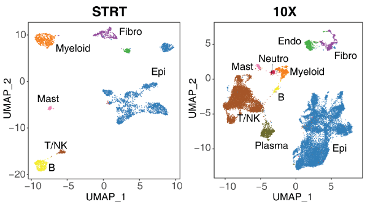
1. 4 prevalent subtypes of malignant cells were identified: the cell cycle program, the mitochondria program, the metabolism program and the epithelial-mesenchymal transition (EMT) program. The progression trajectory of these 4 subtypes of malignant cells is from the cell cycle program, along the mitochondria program, and progressing into either the metabolism program or the EMT program. These 4 prevalent subtypes of malignant cells and their progression trajectory is identified in both these two datasets, which represents the generalization of the finding. Different subtypes of malignant cells have different proportions in individual SBA samples, and different proportions of these malignant subtypes are likely to be associated with different prognosis of SBA patients, which requires future clinical studies on more SBA samples to be explored.
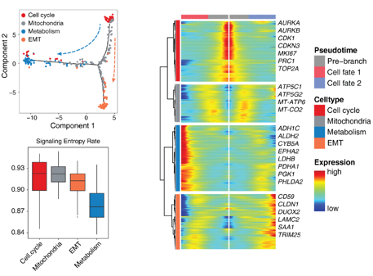
2. Researchers identified that the EMT program malignant cells have a high association with highly exhausted CD8+ T cells. The interactions between EMT-program malignant cells and highly exhausted T cells may reveal the association of the EMT signature of malignant cells and T cell exhaustion in SBA. This finding implies that inhibiting the EMT process in SBA is likely to slow down the exhaustion state of CD8 positive T cells in SBA tumor tissues, thus providing new insights for the development of immunotherapies for SBA.
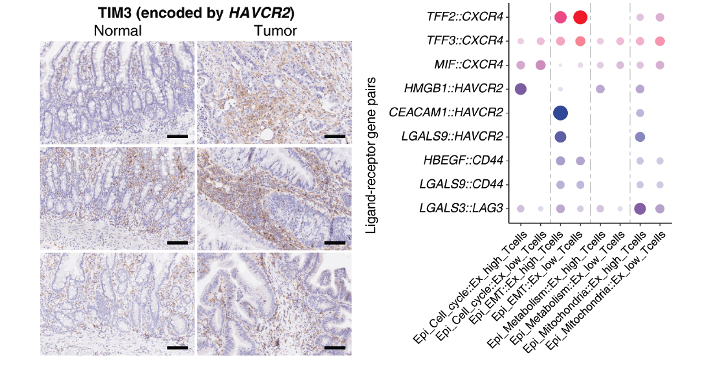
3. With published single cell RNA-seq data of other gastrointestinal cancers, researchers compared gastric, duodenal, jejunal and colorectal malignant cells at the global gene expression levels, and revealed the closer relationship between gastric cancer (GC) & duodenal subtype of SBA and closer relationship between jejunal subtype of SBA & CRC. These ordered relationships are also in accordance with the spatial order of the gastrointestinal tract. Because the current therapies of SBA are mainly referred to CRC, it raises an issue that whether it is an optimal way to treat duodenal cancers with therapies of CRC.
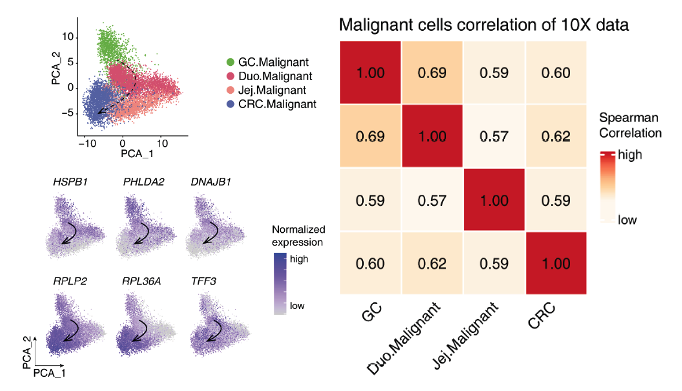
4. Based on the single cell transcriptome signatures of malignant cells and normal epithelial cells, published drug treatment resources and in-depth bioinformatics analyses, specific candidate drugs of SBA were predicted. Verifications of predicted drugs were performed in the HUTU-80 duodenal cancer cell line, and inhibitory effects of volasertib and tozasertib are stronger than classical clinical drugs for SBA such as oxaliplatin and irinotecan when used at the same concentration. These predicated and verified drug candidates may potentially benefit for SBA patients based on the current situation that there lacks specific drugs for SBA. Volasertib is a small molecule inhibitor of PLK1 kinase, which has been approved by the FDA for the treatment of acute myeloid leukemia. Tozasertib is an inhibitor of the Aurora protein family, and relevant clinical studies for various tumor types are in progress. The study found potential therapeutic drugs for SBA and provided important clues for new treatments for SBA.
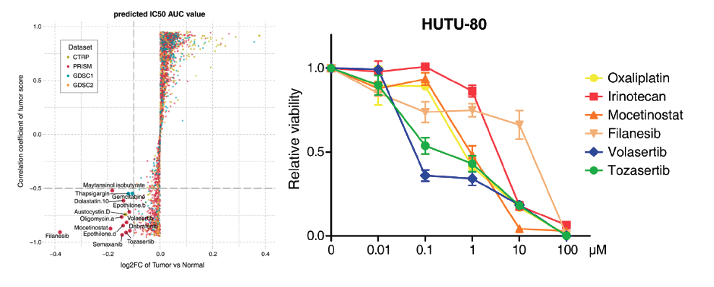
Ph.D. candidate Jingwei Yang from Peking University, Dr. Ji Dong from Guangzhou Bioland Laboratory and Dr. Xin Zhou, Dr. Wendong Wang, Dr. Yongqu Lu from Peking University Third Hospital are the co-first authors of the paper. Professor Fuchou Tang from Beijing Advanced Innovation Center for Genomics and Peking University and Professor Fu Wei from Department of General Surgery, Peking University Third Hospital are corresponding authors. This research project was supported by the National Natural Science Foundation of China and the Beijing Advanced Innovation Center for Genomics.